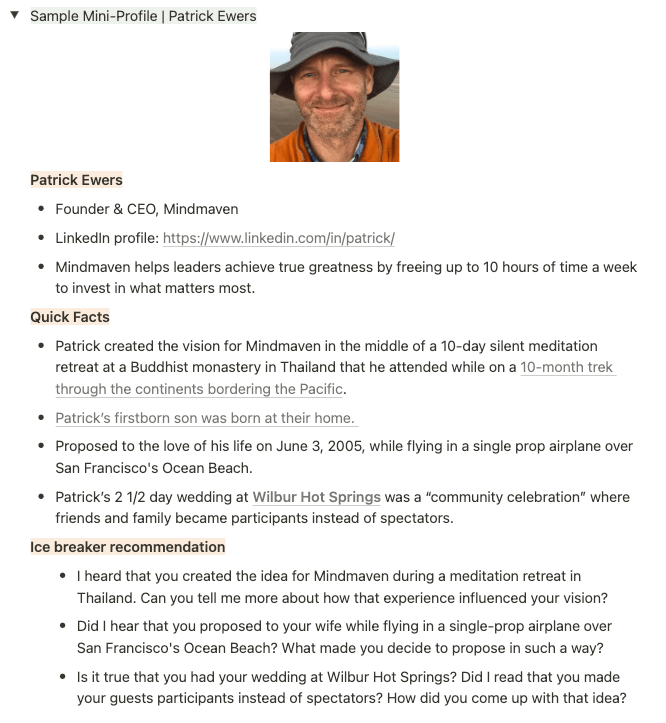Whether you’re meeting with someone for the first time or the fiftieth, the first few moments are vital. They set the tone for the rest of the meeting and potentially your future relationship.
The question is, how do you create a great first or lasting impression? The answer is to deliver something above what’s expected—something personalized. That’s why icebreaker sentences are a valuable tool you can use every time.
Icebreaker sentences are a powerful way to open a meeting and make a great lasting impression.
This article covers the following to help you craft the perfect icebreaker sentence starters.
Table of Contents
ToggleWhat Is an Icebreaker Sentence?
You may have heard of icebreaker games for team-building activities, but what are icebreaker sentences?
An icebreaker sentence is a strong statement or question you can use to kick off a meeting.
Icebreaker sentences are conversation starters that can create an instant connection, establish common ground, and show that you’re genuinely interested in the person you’re meeting. It can also help with creative brainstorming, team member engagement, and group dynamics for workplace productivity and corporate culture.
This was a key topic we discussed with Nick Mehta when we shared our top tips for Human-First Leadership.
Nick emphasized that when leaders normalize icebreaker traditions, they awaken the human element at the start of every meeting. He shared how, at Gainsight, simple but meaningful questions allow them to shift the energy, setting a tone of authenticity and connection. When this happens, everyone becomes more willing to show up as themselves and build trust before business even begins.
For a real-life example of how this might work in practice, imagine that instead of saying …
“Hey, great to meet you. I’m Patrick.”
You might instead say something like:
“Hey Alex, it’s great to meet you. I’m Patrick. Did I hear that you recently attended a 10-day mindfulness retreat? I was inspired to start Mindmaven after a retreat in Thailand. I’d love to hear about your experience!”
The second example uses an icebreaker sentence to open the conversation. It invites them to share their experience and establishes common ground.
Preparing icebreaker sentences only takes a few minutes, but can leave a long-lasting impression.
Breaking the Ice – Examples
Any icebreaker sentence is an intriguing way to start a collaboration. You can do it in just a few short minutes of research before a meeting, and it really helps deliver a great impression when you meet somebody new.
It is also a great personal development tool you can turn into a working habit for building relationships and improving communication skills.
Having a growth mindset for positive reinforcement and habit formation is a top productivity hack.
Here’s an example …
Imagine you’re about to meet with someone called Erin. In your pre-meeting research, you discover she’s been an entrepreneur for the last 15 years and volunteers with Teach for America.
Because you’re also an entrepreneur with a heart for volunteerism, this resonates with you, so you might craft an icebreaker sentence that sounds something like this:
“Did I read that you’ve done some work with Teach for America? I thought that was so cool—I work with Reach Out & Read to promote literacy. What kind of work have you done with Teach for America?”
Erin lights up and says:
“Yes, that’s right! I’ve worked with Teach for America for years, helping underprivileged students see what’s possible when they dream big and work hard.”
She goes on to explain how lucky she feels to be where she is and knows she wouldn’t have gotten here without help from others—so this volunteerism is how she gives back.
And just like that, you’ve got an immediate connection.
So what exactly happened here?
You found common ground, the foundation of every successful new relationship.
How To Use Icebreaker Sentences To Find Common Ground
Common ground refers to shared interests, passions, and challenges that connect us to other people. It may refer to mutual knowledge, connections, or something you can agree on, even if you disagree on other things.
It is a communication short-cut rooted in behavioral psychology that helps us achieve mutual agreement and shared understanding.
Here’s why that’s so powerful …
When you establish common ground with someone, you cause them to think, “I am like you.” But here’s the thing: Studies have shown that our brain translates that thought to “I like you.”
Of course, an example like the one above may only happen once for every 20 people you meet. But if you didn’t take the time to do that research, you’d have missed a huge opportunity.
The Do’s & Don’ts of Great Icebreaker Sentences
So, what makes a great icebreaker sentence?
While some form of an icebreaker is often better than none, there are a few steps you can take to deliver an even better experience to the person you’re interacting with.
✅ Do: Your Research in Advance
If you have an important meeting with someone, don’t rely solely on what limited information you may know about this person. Instead, spend 10-15 minutes (max) researching them.
This doesn’t need to be heavy-duty research. Simply use publicly available information by searching their name on Google, then peruse sites like
- LinkedIn to better understand their professional background.
- Facebook, Twitter, or Instagram to see what’s relevant and important to them.
- Their blog (if they have one) for a better understanding of what matters most to them.
- Their company site for information about their industry, organization, and role within it.
If you work with an assistant, you don’t have to run this process yourself. Simply have your assistant do the research for you, gather the information in an easy-to-reference profile (more on this later), and send it off to you for review.
Mindmaven can help you find and hire an Executive Assistant. Contact us below if you would like more information.

❌ Don’t: Use Absolutes
Just because you read something doesn’t mean it’s true, up-to-date, or accurate.
This is especially important when it comes to contacts with common, easily-misattributed names, and there are few things more awkward than something like this …
“Hey John, I’ve never met anyone with a Ph.D. in both Philosophy and Electrical Engineering. How cool is that!? What inspired you to pursue that path?”
John Smith: “Oh, well, umm … I actually don’t know. I’m not sure where you heard that because I didn’t even go to college.”
You: “Oh, err, my mistake. Sorry. I must have, uh, heard wrong. But, hey, it’s, um, great to meet you anyway?”
For this reason, I recommend avoiding absolutes and always framing your icebreaker sentences as questions. For example, here’s a “safer” alternative to that same situation:
“Hey John, did I hear right that you have a Ph.D. in both philosophy and electrical engineering?”
Then, if he answers yes, you can follow up with something like, “Wow, how cool is that!? What inspired you to pursue that path?” Because you phrased this as a question, it’s much less awkward if your research is wrong.
✅ Do: Leverage Unique Interests
Here’s a real-life example. A client of ours was recently performing their icebreaker research prior to a meeting and noticed the other person consistently live-tweeted every episode of Game of Thrones.
When they walked into the meeting, they said something to the effect of, “Hey Erin, is it true you never miss an episode of Game of Thrones?”
The client told us: “You should have seen the way her eyes lit up at that question. We laid a strong foundation for that relationship with a single, simple sentence.”
Keep an eye out for things that seem to be personally meaningful, something about who they are as a person, not just a professional. If you can’t find anything personal, look for any motivational quotes they may have shared on socials that you also like.
❌ Don’t: Let the Conversation Veer off Course
Icebreakers are a strong way to start any conversation, but they do come with one inherent risk: Derailing the conversation.
If you touch on something truly meaningful to the other person, it can easily turn into a lengthy discussion. And while that discussion is probably great for the relationship, that can come at the expense of business objectives.
If you’re meeting with someone, you probably have a goal you’re trying to accomplish in that meeting—and it’s important for both of you that you leave the meeting feeling accomplished, not just connected.
For more information on how to set effective goals to maximize results, see our Ultimate Guide to Setting North Star Goals.
If you want to come back to the topic, simply take back control of the conversation with a comment like …
“I really want to hear more about that, but I always want to respect your time. We’ve only got about 20 minutes left, and I know we both wanted to talk about [XYZ]. Let’s hash that out and, if we have time, circle back to this.”
✅ Do: Leverage Their Background
 If you can’t find much in terms of unique interests, then spend a little time digging into their background. Try to answer questions like …
If you can’t find much in terms of unique interests, then spend a little time digging into their background. Try to answer questions like …
- Where have they worked in the past?
- Have they had any interesting or unexpected career changes?
- Where have they lived?
With information like that, you can craft icebreaker sentences like …
- “Hey, did I read right that you spent some time in Dallas a few years back? I actually grew up there! Did you ever make it out to Iron Cactus?”
- “It looks like you spent a lot of time working for various corporations before founding your own company. Is that right? I’m curious, what inspired the shift?”
- “It looks like you worked for Snapchat in the early days. Is that right? What was it like back then?”
❌ Don’t: Underestimate Common Ground

Whenever possible, base your icebreaker sentences on common ground or shared interests.
The most obvious form of common ground is shared interests, such as rooting for the same sports teams, engaging in the same hobbies, traveling to the same locations, or watching the same shows.
But that’s not the only place to find common ground.
If nothing else, you can also leverage shared connections, and LinkedIn is a great tool for finding those connections. This keeps it professional and aligns with this leadership secret.
Let’s say you couldn’t find any shared interests with someone, so you visit their LinkedIn profile and notice you’re both closely connected to Rob.
You could use this information to do one of two things:
- You could reach out to Rob and say you are meeting the shared connection to ask for any input, in which case you could start the conversation with an Icebreaker like, “Rob’s told me great things about you! He mentioned that you just finished a round of fundraising. Is that right? How’d it go?”
- Or, if you’re unable to reach out to the shared connection, you could open with an Icebreaker like, “Hey, I noticed we’re both connected to Rob on LinkedIn. I actually worked with him a few years ago. I’m curious: How do you know him?”
Supercharge Your First Impression With Icebreaker Profiles
One more quick tip: Templatize this process by creating what we call Icebreaker Profiles.
Now, ideally, this is a process you’d delegate to your assistant—as it can take up to 20 minutes per person—but the results can be powerful.
An Icebreaker Profile is simply a mini profile that highlights the key information about whoever you’re meeting with.
Here’s a quick recap of how to create a strong icebreaker sentence:
✅ Do your research using LinkedIn, social platforms, company websites, or shared connections.
✅ Look for personal interests or professional highlights that stand out and resonate with you.
✅ Craft a question-based opener that shows curiosity and care (avoid assumptions or absolutes).
✅ Focus on common ground—shared values, experiences, or mutual connections.
✅ Keep the conversation focused so it supports the meeting’s objective while building rapport.
Once you’ve gathered your insights, you can organize them into an Icebreaker Profile.
Let me give you an example of what one might look like:
As with the example above, we recommend using Notion to create Icebreaker Profiles, so you can access and update them in real-time.
As for the content itself, you can customize it based on your needs. An Icebreaker Profile could include the following information:
- Company Website | This can usually be found on the LinkedIn page or with a Google search.
- Offering | A short description of the product or service they offer (usually found on the company website).
- Personal Information | The person’s name, location, and role within the organization.
- Icebreaker Recommendation | A strong opening statement you can use to kick off the meeting that shows you are genuinely interested and took the time to learn about the person you’re meeting.
- Photo | A picture of the person you’re meeting with (especially valuable if you’re meeting in a public place, such as a café, and need to pick them out of a crowd).
- Social Links | LinkedIn, Twitter, Facebook, or a personal blog.
- Additional Info | 3-5 bullet points outlining interesting or unique information about the other person, both personal and professional.
Your Challenge: Try This for Yourself and Notice the Difference
We’ve created this Free Icebreaker Sentence Worksheet you can use to get started straight away.
Open your calendar and take a look at the week ahead. Pick 2-3 meetings, and commit to creating icebreaker sentences in advance.
Then—and this is the important part—use those icebreaker sentences to kick off the meetings.
Although not every icebreaker will lead to an unforgettable experience, see if there’s a noticeable difference in the tone of the meeting for the ones you used icebreaker sentences for.
You can also use the information you gathered to help with writing the best follow-up emails.
Keep in mind: If you have an assistant, you don’t have to do this yourself! Leverage the superpower of radical delegation. Simply send this blog post to your assistant, then delegate the task to them!
Want help putting these strategies into action?
At Mindmaven, we specialize in helping busy leaders build deeper relationships and show up with greater intention—without adding more to their plates.
Through our executive coaching, we’ll help you seamlessly integrate tactics like Icebreaker Profiles into your daily workflow, so you can lead with more presence, connection, and influence.
Schedule a free 1:1 call with a Mindmaven coach to learn how we can support your growth.






